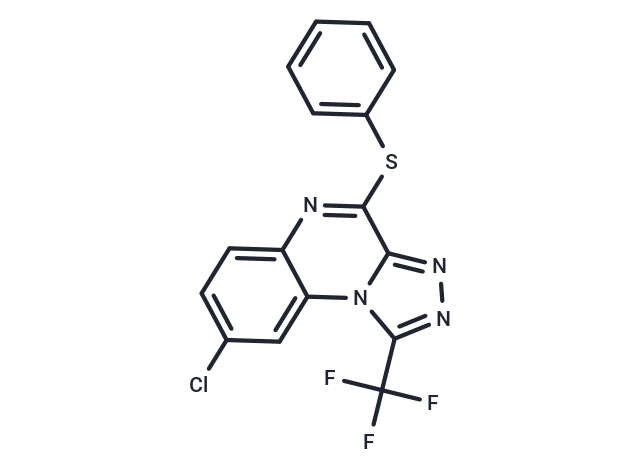Shopping Cart
- Remove All
 Your shopping cart is currently empty
Your shopping cart is currently empty

R-7050 (TNF-α Antagonist III) is a tumor necrosis factor receptor (TNFR) antagonist that exhibits heightened selectivity for TNFα.

| Pack Size | Price | Availability | Quantity |
|---|---|---|---|
| 2 mg | $38 | In Stock | |
| 5 mg | $61 | In Stock | |
| 10 mg | $97 | In Stock | |
| 25 mg | $217 | In Stock | |
| 50 mg | $297 | In Stock | |
| 100 mg | $488 | In Stock | |
| 500 mg | $1,060 | In Stock | |
| 1 mL x 10 mM (in DMSO) | $68 | In Stock |
| Description | R-7050 (TNF-α Antagonist III) is a tumor necrosis factor receptor (TNFR) antagonist that exhibits heightened selectivity for TNFα. |
| In vitro | R-7050 is a cell-permeable triazoloquinoxaline compound that selectively inhibits TNF-α induced cellular signaling. Unlike biologic TNF inhibitors (e.g. Infliximab, Etanercept, Adalimumab) that directly bind TNF-α and function as decoy receptors, R-7050 does not affect binding of TNF-α to TNFR. In contrast, R-7050 selectively inhibits the association of TNFR with intracellular adaptor molecules (e.g. TRADD, RIP), limits receptor internalization, and prevents subsequent cellular responses after TNF-α binding[2]. |
| In vivo | Administered at doses of 6 mg/kg, R-7050 significantly attenuates Evans blue extravasation in brain tissue to 28.7±5.9 μg and 30.3±1.9 μg when given 0.5 hours or 2 hours after induced intracerebral hemorrhage (ICH), respectively, presenting statistical significance (p<0.05 and p<0.01 vs ICH, respectively) and comparability to sham-operated controls. Concurrently, brain water content, indicative of brain edema, increases markedly from 75.6±0.3% in sham to 81.5±0.5% post-ICH (p<0.05 vs. sham). Doses of R-7050 (6, 12, or 18 mg/kg) effectively reduce the brain water content to 78.5±0.3%, 78.3±0.3%, and 79.3±0.5%, respectively, each significantly against ICH (p<0.05) and with no significant difference among the dosages. However, a notable decrease in general activity/locomotion is observed with the highest dose (18 mg/kg). R-7050, at a 6 mg/kg dosage, also significantly mitigates the increase in brain water content post-ICH to levels akin to those in sham-operated mice (p<0.05 vs ICH and not significantly different from sham), demonstrating its potential in reducing both brain edema and permeability post-ICH when administered timely. |
| Alias | TNF-α Antagonist III |
| Molecular Weight | 380.77 |
| Formula | C16H8ClF3N4S |
| Cas No. | 303997-35-5 |
| Smiles | C(F)(F)(F)C=1N2C(C(SC3=CC=CC=C3)=NC=4C2=CC(Cl)=CC4)=NN1 |
| Relative Density. | 1.59 g/cm3 (Predicted) |
| Storage | Powder: -20°C for 3 years | In solvent: -80°C for 1 year | Shipping with blue ice. | |||||||||||||||||||||||||
| Solubility Information | DMSO: 10 mg/mL (26.26 mM), Sonication is recommended. | |||||||||||||||||||||||||
Solution Preparation Table | ||||||||||||||||||||||||||
DMSO
| ||||||||||||||||||||||||||

Copyright © 2015-2025 TargetMol Chemicals Inc. All Rights Reserved.